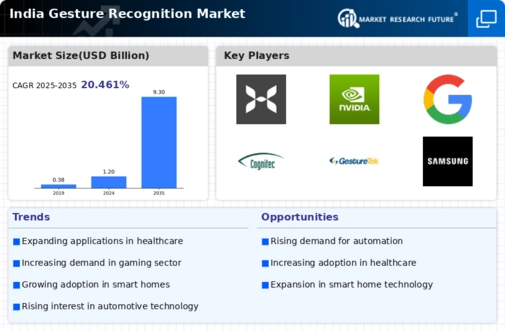Surge in Smart Device Usage
The proliferation of smart devices in India is a pivotal driver for the gesture recognition market. With an increasing number of households adopting smart TVs, smartphones, and home automation systems, the demand for intuitive user interfaces is on the rise. Gesture recognition technology enhances user experience by allowing seamless interaction without physical contact. According to recent estimates, the smart device penetration rate in India is projected to reach 50% by 2026, which could significantly boost the gesture recognition market. As consumers seek more advanced functionalities, manufacturers are likely to invest in gesture recognition capabilities, thereby expanding the market landscape. This trend indicates a shift towards more interactive and user-friendly technology, positioning gesture recognition as a key component in the evolution of smart devices.
Advancements in AI and Machine Learning
The advancements in artificial intelligence (AI) and machine learning are playing a crucial role in shaping the gesture recognition market. In India, the integration of AI with gesture recognition technology enhances the accuracy and efficiency of gesture detection systems. This synergy allows for more sophisticated applications across various sectors, including automotive, healthcare, and consumer electronics. As AI algorithms become more refined, the ability to interpret complex gestures in real-time improves, making gesture recognition systems more viable for commercial use. The Indian AI market is projected to reach $7.8 billion by 2025, indicating a strong potential for growth in related technologies. Consequently, the gesture recognition market is likely to benefit from these advancements, as businesses seek to leverage AI-driven solutions for enhanced user experiences.
Increased Focus on Touchless Interfaces
The growing emphasis on touchless interfaces in various sectors is a significant driver for the gesture recognition market. In India, industries such as retail, hospitality, and healthcare are increasingly adopting touchless technologies to enhance customer experiences and ensure safety. Gesture recognition technology allows users to interact with systems without physical contact, which is particularly appealing in environments where hygiene is a concern. For instance, retail stores are implementing gesture-based kiosks to facilitate contactless shopping experiences. This trend is likely to continue, with the gesture recognition market expected to witness a compound annual growth rate (CAGR) of 25% over the next five years. As businesses prioritize customer safety and convenience, the demand for gesture recognition solutions is anticipated to grow, driving market expansion.
Growth in Gaming and Entertainment Sectors
The gaming and entertainment sectors in India are experiencing rapid growth, which serves as a substantial driver for the gesture recognition market. With the rise of immersive gaming experiences, developers are increasingly integrating gesture recognition technology to enhance gameplay. The Indian gaming industry is expected to reach a valuation of $3.75 billion by 2024, indicating a robust demand for innovative gaming solutions. Gesture recognition allows players to interact with games in a more engaging manner, potentially increasing user retention and satisfaction. Furthermore, the entertainment industry is exploring gesture-based controls for virtual reality (VR) and augmented reality (AR) applications, which could further propel the adoption of gesture recognition technology. This synergy between gaming and gesture recognition suggests a promising future for the market.
Rising Demand for Enhanced User Experience
The increasing demand for enhanced user experiences across various platforms is a key driver for the gesture recognition market. In India, consumers are becoming more discerning, seeking intuitive and engaging interactions with technology. This trend is evident in sectors such as gaming, automotive, and smart home devices, where gesture recognition technology is being utilized to create more immersive experiences. As companies strive to differentiate their products in a competitive landscape, the integration of gesture recognition capabilities is becoming a strategic priority. Market analysts suggest that the gesture recognition market could see a growth trajectory of approximately 30% by 2027, driven by the need for innovative user interfaces. This focus on user experience is likely to propel the adoption of gesture recognition technology, further solidifying its position in the market.






















Leave a Comment